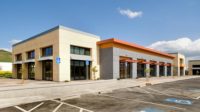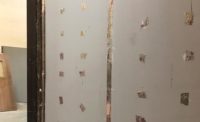Last summer, a six-story steel framed structure withstood multiple massive earthquakes and fires in San Diego. If you don’t remember hearing about this event, here’s why.
Researchers at UCSD Jacobs School of Engineering put a six-story lightweight cold formed steel building through a series of scaled motion earthquakes. The six-story building layout was designed to replicate a multi-family residential structure.*
One of the main purposes of the tests was to see if it was even possible to withstand a historic earthquake combined with an ensuing fire in a multi-story, multi-family structure. The results of the tests as outlined in this article proved that Cold Form Steel Framing could not only withstand the earthquakes and fire but could also be built much more efficiently than traditional wood or concrete structures.
We’re All in This Together
This project was a collaboration between two academic institutions (University of California, San Diego and Worcester Polytechnic Institute), two government or institutional granting agencies (Department of Housing and Urban Development and the California Seismic Safety Commission) and more than fifteen industry partners. Industry sponsors included California Expanded Metal Products Co. and Sure-Board, who provided financial, construction and materials support, as well as DCI Engineers, SWS Panels, Rivante, State Farm Insurance, The Insurance Institute for Business and Home Safety, DPR Construction, Walters & Wolf, and MiTek who also provided support.
The test building was subjected to a sequence of seven earthquake motions prior and two motions following the fire tests on the second and sixth floors. The input earthquake motions adopted in for the shake table testing were selected from four historical earthquake records, namely: Rio Dell Overpass from the 1992 Cape Mendocino earthquake, Canoga Park and Rinaldi Receiving Station both from the 1994 Northridge earthquake and Curico from the 2010 Maule earthquake in Chile.
This was the tallest cold form structural steel building ever to undergo tests on a shake table. This type of building is lighter than a concrete building of the same height so it has less mass to generate damaging forces.
Shaken, Not Stirred
The purpose of the UCSD shaker table test was to construct a building per the current CBC & ASCE 7-10 design requirements at an R = 6.5. Using a combination of cold form steel framing, Sure-Board wall and diaphragm shear (Series 200&200S) as well as Zone 4 tie down system; the building was then subjected to a real-world earthquake scenario. This building was not built on “performance based design” as most of the predecessors were before, thus giving a true outcome of how a field built structure might react in a real earthquake. Some of the benefits that this system can offer in this type of construction are its inherent non-combustibility, higher shear and diaphragm capabilities compared to similar types of construction methods, as well as offering the ability to have a habitable and safe structure after such a large natural event.
Are You Sure?
The Sure-Board system is a non-combustible floor sheathing. The Series 200S is unique in its ability to be installed by a single person, as well as eliminating the necessity for blocking at panel joints due to its proprietary tab feature. While Series 200 shear panels have the finish board already laminated to the .027(22g) sheet steel, the installer is applying their lateral shear and non-combustible finish board in one-step of labor instead of two. Beyond just their installation benefits, these products installed in conjunction with the Zone 4 tie down system created a dynamic and ductile building. This structure could withstand multiple ground movements, including a 150 percent MCE (Maximum Considered Earthquake) of the 1994 California, Northridge earthquake, while only suffering superficial cracking on exterior walls. This system proved not only to be resilient, but capable of handling future unforeseen events, while keeping its occupants safe.
The UCSD shaker table program was designed to test this system’s seismic shear capabilities, as well as fire resistance and resilience, however this type of construction has many other benefits that can be useful nationally, even worldwide. It can be easily panelized and erected quickly on site, as well as all of the products used are mold, termite and weather resistant. This system has also been tested for use in catastrophic events such as hurricane force winds, flying debris and even as far as Blast & Ballistic protection. With these accomplishments, there is great opportunity for future designs.
The Cheaper, the Better
Cold form steel framed structures can offer lower installation and maintenance costs than other structural types, particularly when erected with prefabricated assemblies. They are formed of an inherently ductile material of consistent behavior, lightweight, durable and manufactured from recycled materials. Compared to other lightweight framing solutions, CFS is non-combustible, which is an important basic characteristic to minimize fire spread.
Knowing that the structure would be tested under substantial movement before and after a fire, it was also important to see how the fire-rated building joints would perform. For the head-of-wall joints, two different forms of fire protection were installed and observed. The traditional method of paper tape and joint compound was applied to some of the perimeter joints while other head-of-wall joints were treated with CEMCO HOTROD Compressible Intumescent Firestopping.
Test Results:
Pre-fire Earthquake Tests: The test building suffered minimal damage during the service level earthquake tests and remained largely in the quasi-linear range, with very low drift demands imposed on the specimen (interstory drift < 0.2%).
Fire Tests: Post-flashover conditions were achieved in all six compartment fire tests at the given ventilation conditions, with the corresponding maximum compartment temperatures ranging between 800 and 1,100 °C (four out of six tests exceeding 1,000 °C). The elevated temperature caused significant degradation of interior fire rated gypsum wallboards on sheet steel and plain fire rated gypsum wallboards leading to the loss of some structural strength.
Post-fire Earthquake Tests: The low-amplitude aftershock significantly attenuated seismic demands in the building because of the elongated period caused by the pre-fire earthquake sequence. However, the test building resisted collapse due to redistribution of loads and framing action of the SureBoard and the Zone 4 tie-down system. Not only did the structure resist collapse, researchers were still able to safely walk through the test building and analyze the structures’ post-fire/earthquake condition.
“As the nation’s largest general contractor that self performs drywall, we at DPR Construction were proud to participate in the seismic performance test of steel stud construction. The test results make a very compelling argument for steel stud framed buildings in lieu of wood and even concrete. Changing the building codes to utilize these construction materials is the first step in building safer, more sustainable communities. DPR will keep leading change in the building industry alongside companies like CEMCO Steel.”
— Carl Spaete DPR San Diego
References:
Earthquake and Fire Performance of a Mid-Rise Cold-Formed Steel Framed building – Test Program and Test Results: Rapid Release Report by Xiang Wang, Tara Hutchinson, Gilbert Hegemier, Srikar Gunisetty (UCSD), Praveen Kamath, Brian Meacham (WPI).










